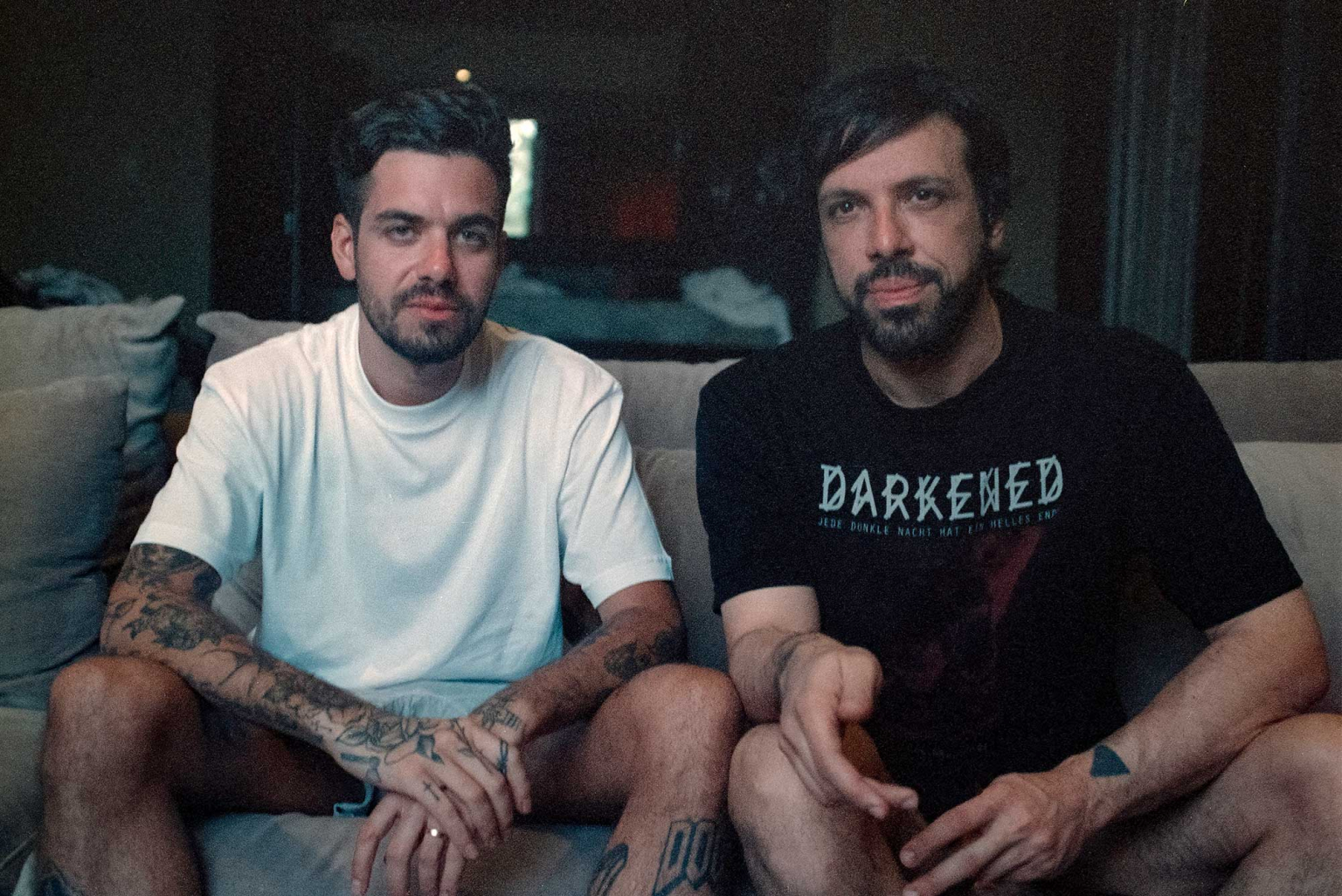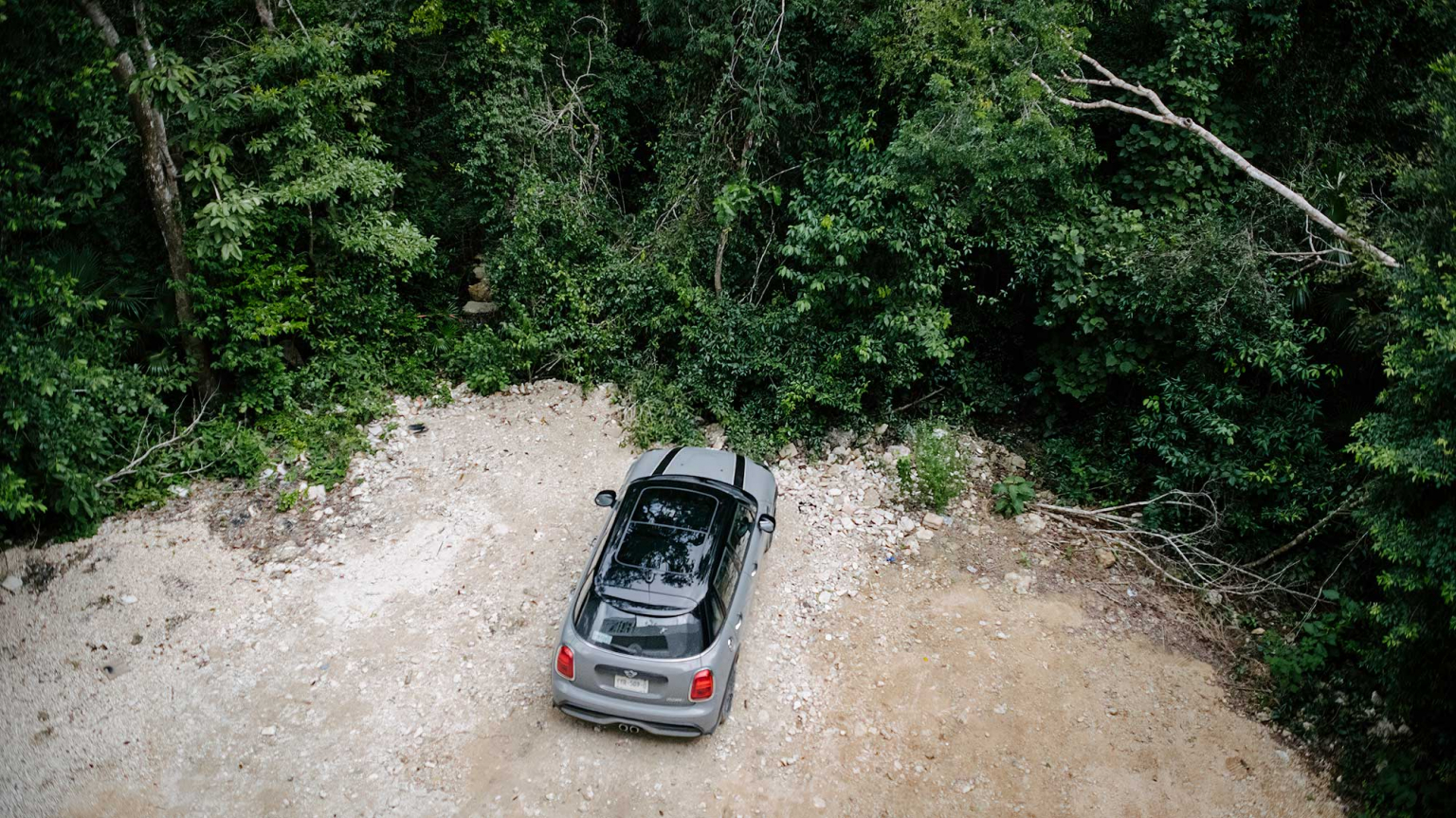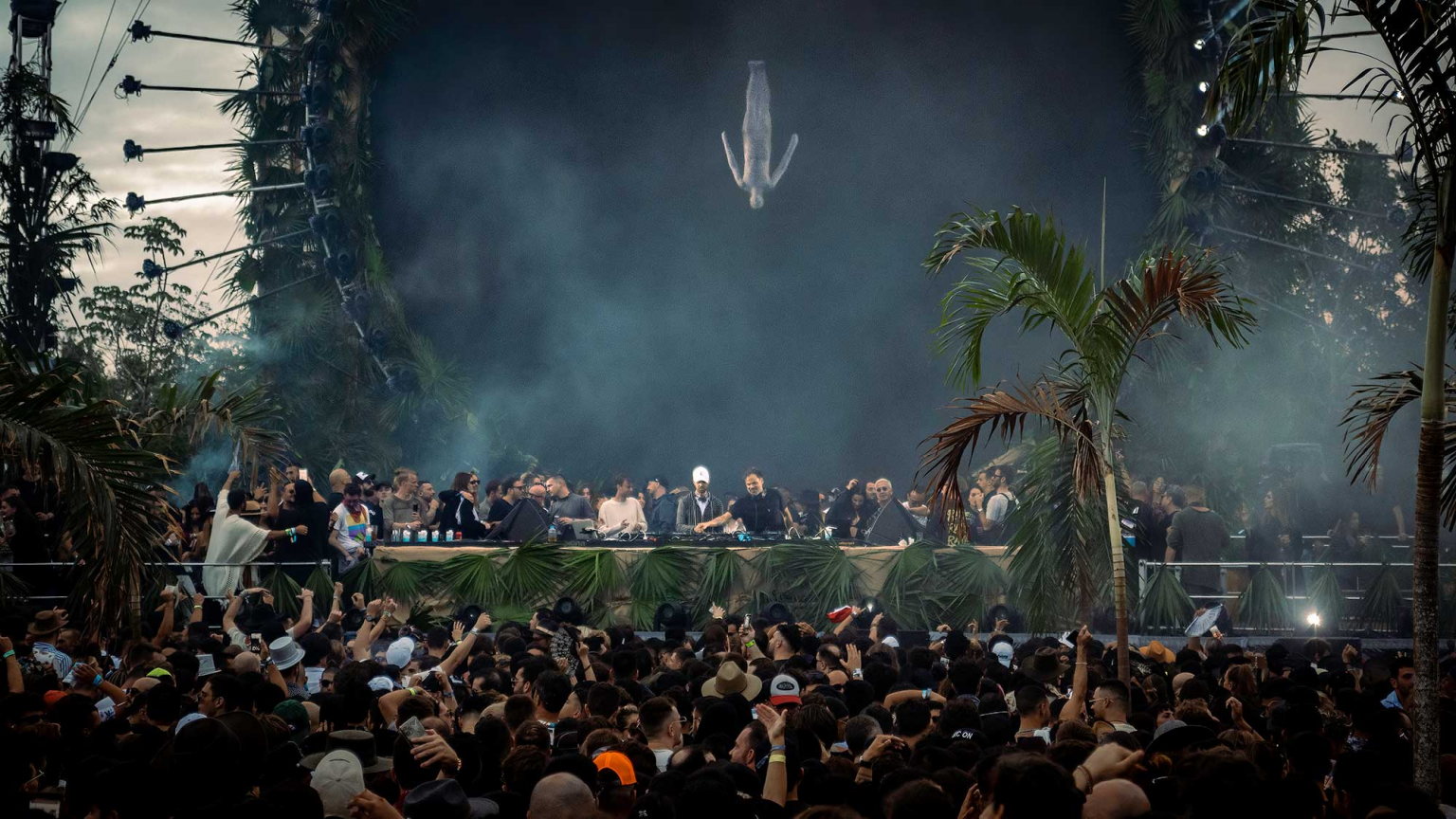
Story by Luke Whyte, Editorial Director | Photos by Nathan Beer, Visuals Editor
Fear & minting in Tulum: Could artist DAOs revolutionize the music industry?
Zero hours and zero minutes
I’m waiting in line to board a flight at Gate C6 of Houston’s George Bush Intercontinental Airport behind a man whose God-given right to epidermic liberty refuses to be restrained beneath his double XL t-shirt. With his lower back hair tufting out like a plumber’s merkin, he personifies this journey (this American right of passage) from Texas to Cancun.
In fact, this whole flight is a parody of itself. It always is. A primary American export: One (1) fuselage of swollen stomachs, breasts and biceps packaged in Tommy Bahama and tribal tattoos that will try to order a margarita before take-off and get shipped back reddened and queasy[1] 3-6 days later.
I don’t plan on stopping in Cancun, but instead renting a car and driving to its successor: Tulum. A strange, boutique replica of the same decadence, Tulum can be thought of as the affluent Millenial’s Cancun – less “20 shots of tequila” and more “five bottles of orange wine.[2]” Located in the Riviera Maya of Mexico’s southeast coast, it’s a tantalizing combination of private luxury nested in tropical vegetation with back balconies opening to Instagrammable beaches. I’d driven through the town at least four times before I first stopped last February. We pulled into a local convenience store at around 9PM and, inside, I watched a muscle tee-adorned man with a Southern California accent shout the word “toothpaste” over and over at a confused and slightly frightened attendant.
Today, I’m returning to report on what I’ve been told could be the seeds of a music industry revolution: Equitably distributed royalties, fan ownership, and creator empowerment, all achieved without having to ask Sony or Warner Bros. for permission. At the center of this insurgence are two Italian men: Matteo Milleri, one half of the renowned Italian techno music project Tale Of Us, and Alessio De Vecchi, celebrated 3D artist and Chief Curator of the NFT platform SuperRare. Their vision, Anyma, could become the first large scale music industry use case for blockchain and NFTs: one that doesn’t discard existing tools like Spotify, but manipulates them to build fan-owned enterprises and cut out parasitical middlemen.

Matteo Milleri, left, and Alessio De Vecchi, right
It’s Monday at 7:30PM when we touch down. A tropical storm thunders against the tarmac and my stomach churns. I’ve got 46 hours to locate Matteo and Alessio for an interview at a former Pablo Escobar mansion turned luxury hotel on Tulum’s costal jungle, attend Afterlife, a nine hour live performance by Tale Of Us (2AM-11AM) culminating in the display and sale of one of Alessio’s NFTs on a 100ft tall screen at sunrise, and then drive sleepless back to Cancun in time for my return flight.
Afterlife is one of 11 Tale Of Us shows over 12 months at which one of Alessio’s NFT artworks will be released as a capital raise for Anyma. As a venue, Tulum holds no special value to the project, but as a cautionary tale to the NFT community, I’d posit it’s packed with lessons.
Unless you spent the last 12 months ducking COVID on the Appalachian Trail, you’ve probably noticed the NFT space had a hell of a year – a wild year, a profitable year, arguably a terrifying year. Though JPEGs have been on the blockchain since 2016, it wasn’t until early 2021 that people started putting enough faith in their future to add six zeros to their price tags.
Ask any enthusiast what makes NFTs special and they’ll say, “the community.” And there is something unique there. Blockchain networks allow for peer-to-peer connections – direct artist to collector relationships – and have enabled a sort of anarcho-capitalist system of investment and support without the need for galleries, record labels, or other hierarchies.
In the early days, it seemed the community’s most successful members were those that invested back into other members’ projects. And yet, by last summer, prices had risen to a point that most promising NFT projects were accessible only to the super affluent. “Investing back into the community” was starting to look like “investing back in anyone else positioned to risk $20,000 on a volatile token.” By December, the wealthiest investors were plastering animated GIFs on Times Square billboards like boys with a ruler in a middle school bathroom stall, while the day trading class met at private parties in Miami nightclubs to dance around bikini-clad models holding cardboard cutouts of cartoon “Bored Apes.”[3] For all the promises of revolution, you had to wonder if this was much different from the systems that came before it.
And you can’t be faulted for worrying that NFTs are no more than a multi-level marketing scheme. Sure, maybe you can see the value in the fine art digital assets that have been purchased for thousands of dollars, but what about the 8-bit pixelated profile pics now selling for millions at Christies?
Some will insist you put faith in the future of the “metaverse” – the foretold augmented hyperreality that Mark Zuckerberg so lustfully aims to make his own. But when? In five years? 50? And do we really want to live in a Minecraft server anyway? Isn’t this all just some virtual Tower of Babel built by tech bros, Wall Street sharks, and art speculators, climbing to the moon on faith and hubris alone?
Well, maybe. Or maybe these are just growing pains.
One thing that is clear is that if NFTs are going to avoid going the way of Dutch tulips in the 1630s or Beanie Babies in the 1990s, this year needs to see projects that create measurable value for more than a handful of speculators.
Anyma could be one of those projects.

The view from our balcony, the weekend’s noble steed
Two hours and fifteen minutes
After some pleading and price gouging, photographers Nathan Beer, Kenzie McMillan, and I clamber into a rented Mini Cooper and head south. It seems every tourist is following suit, abandoning Cancun for Tulum.
Long past are Cancun’s ‘90s heydays, when MTV would pipe footage of dancing swimsuit-clad coeds from its beaches to the living room of every 13-year-old boy watching “The Grind” with the lights out and his hands under a blanket. Today, the city’s reputation has sunk from sexy to saturated. Discarded by tourism’s elite, what remains is a sometimes dangerous, often depressing, culture of Vegas-style hedonistic consumerism.
Tulum, on the other hand, until recently was no more than a village with a beach. When the fashion photographers and boutique hotels began arriving in the mid-2000s, there was promise of something different than Cancun: a loving destination for beautiful, barefoot people wishing to embrace the spirituality of the local Mayan community. But demand and money came too fast. In the words of Reeves Wiedeman[4], “in barely more than a decade, Tulum transformed from a backpacker’s beach into the next stop after Ibiza on the global DJ party circuit.” “Eco-friendly” hotel rooms with diesel generator-powered air conditioners now rent at rates comparable to Paris or New York. Tulum has become a foreign-owned playground for the rich, less a loving community and more something to be consumed and discarded as soon as the next unspoiled paradise is discovered[5].
There is a parallel between what is happening in Tulum and in the NFT space. The wealthy and the stylish have turned a struggling space into a flourishing one. And yet, with unfettered growth came an unfettered greed at high risk of destroying the thing it loved.
Arriving at midnight, we sit around with local friends Jesus and Rosalinda discussing the increase in kidnappings and gun violence. Our neighbor shouts from the balcony: can anyone sell him some weed?

“What’s your number, we’ll start a Whatsapp group”
Twenty one hours and forty minutes
We’re late. We were supposed to meet with Matteo and Alessio almost an hour ago but the Mini Cooper is stuck behind an infinite line of taxis on a long dirt road canopied by arching papaya and palm trees.
This is Tulum’s five mile beach strip where the fantasy unfolds. Stylish couples with good skin and filled lips flaunt ribbed stomachs and booty shelves, meandering from foreign-owned boutiques selling 20 manifestations of the same Aztec print sundress to soft lit open air bars where a mixologist with a man bun will make you a mezcal cocktail afront a neon sign suggesting you do something cliche/platitudinous like “Follow Your Dreams.”
There is a name for this aesthetic, but I can’t place it. “Boho-chic?” Kenzie suggests. I don’t know. All I’m sure of is we’ve been stuck beside the same vape pen vending machine out front a pharmacy advertising anabolic steroids and Viagra for the last 30 minutes, and Alessio keeps texting me to hurry.
Eventually we reach the less trafficked end of the road populated by the most opulent hotels. A sand path walled by candlelit railroad ties leads us to the villa Matteo has rented with his Italian wife, model Vittoria Ceretti.
“Nice to meet you,” Matteo says, barefoot, at ease, as we shuffle across a plush carpet to a wraparound couch pointing into the jungle canopy through an open, wall-to-wall window. There is tranquility. Tropical birds whistle. We sit.

Luke, left, and Matteo, right, discuss Blockchain’s great promises
Born in New York, Matteo moved to Italy at a young age where he met Carmine Conte, the other half of Tale Of Us. In 2011, they released their first EP and – led in part by their immersive live shows – have since become a powerful force in the techno music touring circuit with a loyal fanbase.
This afternoon he’s dressed in a well-fit, white t-shirt and shorts, slender in shape and tattooed from palm to foot. He crosses his legs tightly, leans back, and takes time to articulate his words, not expecting to be interrupted.
I ask him about the roots of the Anyma project.
“The influence of art, and especially digital art, was always very strong in my music and in my performances,” he says. “So I said, ‘Ok, I’ll create my own environment. I’ll procure the communication. I’ll create the production. I’ll curate where it starts and where it ends. [I’ll create] the mood…’ So the people go into it like they go into the theaters. They are transported on a journey. So that was the beginning. And to do this I needed real art. Because the music wasn’t enough.”
By “real art” he means Alessio, who he invited to his home in Ibiza last summer.
Alessio is tall, animated, and opinionated about most everything, yet vulnerable in that way the most creative among us can be. Much of his work involves these beautiful, surreal worlds that fantastical characters interact with in ways that speak to the human condition. In 2020 he was accepted to SuperRare where he began minting his NFTs. Soon the platform offered him a job as Chief Curator and he was selling pieces for upwards of $100,000.
“The Pact” by Alessio De Vecchi
“In my opinion,” Alessio says, “the problem we have with NFTs is that there’s no bridging between our scene and reality. Our scene is a fucking bubble. So Mateo said, ‘Okay, I play in front of 20,000 people every two weeks. We can start implementing these fucking visuals and people will start to get it,’ like, ‘Oh, this is an NFT. So somebody owns it, right?”
As mentioned, 11 of Alessio’s artworks will become visuals in 11 Tale Of Us shows. 10 of them will then be sold for 50ETH (around $160,000 at time of the event) in order to finance development of the central component of Anyma: a decentralized autonomous organization, or DAO.
If you’re not scrolling crypto Twitter every day, you might never have heard of DAOs, but it’s worth paying attention. They could quickly rise to prominence in 2022.
If a blockchain is like an accounting ledger that uses code instead of accountants to track transactions, a DAO is like a corporation that uses code instead of officers and employees to manage shareholders’ investments. Similar to how corporations are organized around rules carried out by employees and bylaws, DAOs are organized around rules executed by code. They’re built atop blockchains, which they use to confirm their transactions. Instead of distributing shares that dictate investor ownership and voting rights, DAOs distribute tokens toward the same end. Thus, if a DAO issues one billion tokens and you hold 500 million of them, you control half of the DAO. Inevitably, tokens find their way into free exchanges where they find market value and disseminate to regular investors.
In the last couple years we’ve seen DAOs form for an increasing number of use cases. Some serve a strict investment purpose, like an index or hedge fund. The NFT world has seen a huge spike in art collection DAOs. Another intriguing use case is governance: Similar to a corporation, a DAO can be used to organize a network or business, allocating voting power through tokens and, hopefully, eradicating traditional hierarchies and corruption.
Anyma will deploy a DAO through which all the artists’ royalties will flow. “The music royalties will get distributed to the token holders,” Alessio says. Initially, a high number of tokens will be dispersed among the artists and the 10 NFT investors. Longer term, mechanisms will be devised to get tokens into the hands of all members of their community: fans, stagehands, opening acts.

Without those behind the scenes, there would be no scene
“We are starting with this niche collection for high-end collectors, to raise, let’s say, the funds to create the organization and empower the creators, which, for me, means getting out of deals with major labels,” Matteo says. “So no more advances to produce, no more advances to get out of publishing deals, get out of all these management deals where they find you a brand; all the shit you need to do to raise money, to do cool shit.”
The 11th NFT from their 11th show will be transferred to the Anyma DAO vault: the first asset to be owned by the community, like a Rembrandt held by a trust. Then as the DAO matures, Matteo intends to put tokens into the hands of his fanbase. “That is going to be the way to empower the people that usually we’re just asking for money,” he says. “Because for 10 years, I’ve been asking my fans for money. Soon I’ll get to give back.”
At such a point, if you are a fan and Anyma token holder, just by attending a show or playing a Tale Of Us track on Spotify, you’ll be boosting your personal bottom line.
“I’m giving back everything I make from the music to the community,” Matteo said. “I’m not making any money with the music anymore. But, of course, I’m also holding the token. So I’m like them: All the music is all to the community and we all have proportionate amounts of token based on how much we invest in it.”
Victoria taps Matteo on the shoulder. We should leave so they can nap. The Afterlife festival starts in eight hours.

The beautiful chaos awaiting us
Thirty-one hours and forty-five minutes
By 3AM, the Mini Cooper is parked and we’re walking through the gates into Afterlife. The bass beats its chest through the ground. Earlier Matteo had said he envisions a world in which technology has advanced to a point where every facet of his shows become part of a living art experience, a transhuman journey through a hyperreality. Given what’s available today, he’s had a pretty good stab at it tonight.
Walking through the angular wooden tunnel beyond the opening gates, blue and green lights splinter through tropical vegetation, a wormhole into Afterlife. A sea of DayGlo-splashed and flower-crowned influencers dance and skip through. Cowboy hats and bunny ears, shaved chests and bone necklaces. Flowing dresses, fishnets, and painted ass cheeks. Dilated pupils.
“You need ecstasy? Coke? Weed?” I’d bet MDMA plays a role in how they’re touching each other in that ankle-deep wading pool.
There must be tens of thousands of people. I feel outside of it all, an observer scribbling into a notepad I ripped in half to fit in my pocket like a court stenographer who lost his grip to meth. Our wristbands are the premium shit, not just backstage but onstage, and the more security checkpoints we pass through, the skinnier the women seem to get.
Up on stage the view is wild. The lightshow and 100ft visuals transform the night. Not arbitrary colors but calculated moods crashing across and filling the crowd. I feel as if stranded on a tiny tropical moon circling Jupiter with 20,000 lustful millennials – all possible investors in Anyma’s future.

And, oh boy, what beautiful chaos it was
The hours melt. The mood ebbs and flows. And then the sun rises. On a 100ft tall circular screen behind the stage adorned in a giant frame of lush vegetation, Alessio’s artwork appears. It’s titled “The Pact” and features a human and robotic hand dancing and rotating around one another without touching, like teasing lovers. Suddenly, the index fingers connect and a deep golden ring ripples from the artwork’s center. The canvas fills with light.
Sometimes, I get the sense that people come to festivals like this to tap into something primal, to lose themselves in a sea of bodies, sweating, dancing, bonding. For a moment in time there is empathy among strangers, there is understanding, there is, it seems, community.
Two days later, “The Pact” will sell for $159,770 to someone named @zalaxyhot4269 on SuperRare.

Tale of Us doing what they do best, and with quite a view
Forty-one hours and ten minutes
It’s noon and we’re barreling in the Mini Cooper back toward the Cancun airport. Kenzie’s asleep in the back. Nathan’s reviewing footage and I’ve got time to think. If last year was the year of the NFT, there’s no reason 2022 couldn’t be the year of the DAO. Anyma is just one of many promising DAOs germinating in the NFT space, and the optimist in me wants to believe their utility and accessibility might not only save digital art from a devastating market correction but could, one day, become a tool in ushering forward a more equitable era of human governance and cooperation. The pessimist in me, however, is thinking about the parallels between this region and the NFT space, about the devastating impacts of unchecked growth and greed – consuming communities and rotting value like human melanoma. With this in mind, I can’t stop reliving the memory of our first night in Tulum:
Hungry and restless at around 1AM, Jesus, Nathan and I had driven to a taco stand selling tripas, a cow’s small intestines, arrachera, a boneless portion of steak cut from a cow’s diaphragm muscle, and al pastor, pig meat marinated in spices and spit-grilled. We order and wait. A sweet beige and white collie-mix street dog coils up on the ground, softly licking a wound on her foot.

“Table for two!”
Suddenly, a furious taxi driver parked in front of the stand starts his van, matts the accelerator, and drives right over the street dog. If he didn’t know he hit her when the front tire rolled over, he certainly knew when the rear one did.
The dog yelps out in pain and horror. It flips and writhes on the ground. The taxi disappears. The dog’s intestines have been crushed. Nathan pets her head as a circle forms around her. She gasps. Jesus doesn’t stand up but all the gringos are frantic. We are distraught. We are beside ourselves. The dog dies right in front of us.
One of the cooks pulls a trash bag from his truck, puts the body inside and carries it to a public trash can. For a moment there is silence amid the mourners, there is a sense that something is wrong here, that something should be done. Then, one by one, as our tacos get served, we pop over to sink our teeth into the meat.

RIP bud, we hardly knew ya
Art

Curated Conversations: ALIENQUEEN
SuperRare Labs Senior Curator An interviews ALIENQUEEN about psychedelics, death, and her journey in the NFT space.
Tech


Out of the Vault and onto the Chain: the Evolving Nature of Provenance
SuperRare editor Oli Scialdone considers the social experience of provenance and its relationship with community in the Web3 space.
Curators' Choice



Curated Conversations: ALIENQUEEN
SuperRare Labs Senior Curator An interviews ALIENQUEEN about psychedelics, death, and her journey in the NFT space.



